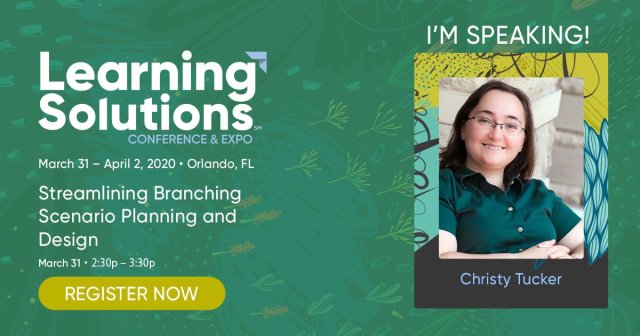Cutscenes in Branching Scenarios
Author: Christy Tucker
Go to Source
In video games, cutscenes are short, non-interactive scenes that “cut away” from the action. They can move the plot forward, show conversations, or build emotion. We can borrow this technique from video game design when we develop branching scenarios for learning. This helps manage the complexity of building branching scenarios.

In branching scenarios with simulated conversations, sometimes we see every single exchange built as an interaction. With that approach, if you’re controlling a character, then every single sentence that comes out of that character’s mouth has to be a decision point.
Example without a cutscene
Here’s what that might look like. The answers in bold are the selected choices for the next part of the dialogue. (This is excerpted from the middle of a larger scenario.)
Decision point 1
Sophie: OK, so you have two big goals with moving to online. First, you want to eliminate the travel costs. Second, you want the training to be shorter, in smaller chunks, so managers can still do their jobs while they’re being trained. Has the training itself been successful so far?
Robert: Yes, our classroom training has been well received. We have good scores on our satisfaction surveys.
What should Sophie ask next?
A. Are you measuring anything else about the effects of your training?
B. Have the trainers provided any feedback on what could be improved?
C. What level elearning do you want the final product to be?
Decision point 2
Robert: What do you mean?
What should Sophie say next?
A. Change the topic; this level of evaluation isn’t important at this stage.
B. Give an example of a measurable business outcome.
C. Explain Kirkpatrick’s 4 levels of evaluation.
Decision point 3
Sophie: Well, this is manager training, right? So maybe one outcome from that would be lower turnover for employees whose managers have been through the training.
Robert: Ah, I see. That would be great, but I don’t have any of that data right now. Could you help me figure out how to measure that? I’d love to be able to show that value to my managers.
What should Sophie say next?
A. Sorry, but you’ll have to get those numbers to me before we can proceed.
B. I can include that in the price for the project. Let’s talk about road mapping.
C. I can include that in the price for the project. Let’s talk about more details so I can give you a firm estimate.
This is 3 decision points, each with 3 choices. That’s 10 screens that have to be built.
Example with a cutscene
If this is a cutscene, all of the dialog continues seamlessly. You see some back and forth between the two characters before having a single decision point at the end. Instead of 10 screens, this is only 4 to build (the conversation shown here plus the results of the 3 choices).
Sophie: OK, so you have two big goals with moving to online. First, you want to eliminate the travel costs. Second, you want the training to be shorter, in smaller chunks, so managers can still do their jobs while they’re being trained. Has the training itself been successful so far?
Robert: Yes, our classroom training has been well received. We have good scores on our satisfaction surveys.
Sophie: Are you measuring anything else about the effects of your training?
Robert: What do you mean?
Sophie: Well, this is manager training, right? So maybe one outcome from that would be lower turnover for employees whose managers have been through the training.
Robert: Ah, I see. That would be great, but I don’t have any of that data right now. Could you help me figure out how to measure that? I’d love to be able to show that value to my managers.
What should Sophie say next?
A. Sorry, but you’ll have to get those numbers to me before we can proceed.
B. I can include that in the price for the project. Let’s talk about road mapping.
C. I can include that in the price for the project. Let’s talk about more details so I can give you a firm estimate.
See the cutscene in action
You can see the cutscene in action on its own or as part of the complete branching scenario. This cutscene actually includes some additional dialog prior to the script shown above.

I wrote about the specifics of building a simulated phone conversation previously.
Advantages of cutscenes
Simplify the scenario
The biggest advantage of showing a conversation in a cutscene like this is reducing the total number of slides (from 10 to 4) and decision points (from 3 to 1). That reduces time building the other options, as well as the time writing plausible distractors for the additional decision points.
Meet critical objectives
The cutscene moves the conversation forward quickly to get to the next critical point. In this particular example, the objective is to propose a road mapping. That needs to be a decision point.
The other parts of the conversation aren’t as critical for the learning objective. Therefore, it’s not as important for them to be decision points. I can collapse that dialogue into a single, non-interactive conversation. We need the context, but not everything has to be a decision point.
Streamlining branching scenario planning and design
I’ll be talking about cutscenes and other tips for making branching scenarios easier and more manageable in my session at the Learning Solutions Conference, Streamlining Branching Scenario Planning and Design.

I’m also leading a Morning Buzz discussion on using stories and scenarios for learning. Please join me if you’re planning to attend Learning Solutions!

The post Cutscenes in Branching Scenarios appeared first on Experiencing eLearning.
